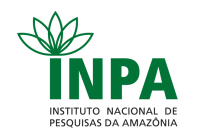Corpo Discente - Egressos
Pedro dos Santos Panero
| Título | POTENCIALIDADES DAS ESPECTROSCOPIAS NIR E MIR ASSOCIADAS AOS MÉTODOS QUIMIOMÉTRICOS APLICADOS AOS ÓLEOS VEGETAIS DOS FRUTOS DE PALMEIRAS DA AMAZÔNIA - RORAIMA | ||||||||||||||||||||||||
| Data da Defesa | 18/06/2018 | ||||||||||||||||||||||||
| Download | Em sigilo | ||||||||||||||||||||||||
Banca
| |||||||||||||||||||||||||
| Palavras-Chaves | Óleos vegetais; Espectroscopia; MIR; NIR; PCA; HCA; SIMCA; PLS | ||||||||||||||||||||||||
| Resumo | Neste trabalho, realizou-se a tipificação dos óleos vegetais das polpas de buriti, tucumã, inajá e pupunha, assim como a classificação geográfica, discriminação de estágio de maturação e quantificação de ferro em óleo da polpa de buriti. As amostras foram coletadas em 14 dos 15 municípios do estado de Roraima, os óleos foram obtidos pelo método de extração Soxhlet e analisados por meio da espectroscopia nas regiões do Infravermelho Próximo (NIR) e Médio (MIR), aliadas aos métodos quimiométricos de Principal Component Analysis (PCA), Hierarchical Cluster Analysis (HCA), Soft Independent Modeling of Class Analogy (SIMCA) e Partial Least Squares (PLS). Nos modelos de tipificação dos óleos por NIR (Bomem) - PCA, NIR (Bomem) - HCA e NIR (Bomem) - SIMCA utilizou-se os espectros nas regiões (5450 – 5766 cm-1 e 7124 – 11436 cm-1). As regiões espectrais utilizadas nos modelos de classificação geográfica foram para NIR (PerkinElmer) - PCA e NIR (PerkinElmer) - HCA (6250 – 10000 cm-1), MIR (PerkinElmer) - PCA e MIR (PerkinElmer) - HCA (450 – 4000 cm-1), NIR (Bomem) - PCA (6453 – 11436 cm-1) e NIR (Bomem) - HCA (4586 – 8906 cm-1). Para os modelos de maturação NIR (Bomem) - PCA e NIR (Bomem) - HCA, as regiões espectrais usadas foram de (5450 – 5766 cm-1 e 7124 – 11436 cm-1). No modelo de quantificação de ferro MIR (PerkinElmer) - PLS a região que apresentou melhor resultado foi entre (450 – 4000 cm-1). Em todos os modelos construídos obteve-se excelentes resultados, com a tipificação, classificação e discriminação das amostras com 100% de efetividade. O modelo de quantificação de ferro apresentou predição considerada boa, com erro relativo médio inferior a ± 7,00%. Todos os métodos empregados demonstraram-se potencialmente eficientes e alternativos aos métodos tradicionais, com as vantagens de não utilizarem reagentes prejudiciais ao meio ambiente, não gerarem resíduos nocivos ao operador, manterem a integridade da amostra e serem capazes de fornecer resultados em segundos, sem a necessidade de manipulação da amostra. | ||||||||||||||||||||||||
| Abstract | In this work, it was performed the typification of vegetable oils from the pulps of buriti, tucumã, inajá and pupunha fruits, as well as their geographic classification, maturation stage discrimination and iron quantification in the buriti pulp oils. The samples were collected in 14 of the 15 municipalities of the state of Roraima. The oils were obtained through the Soxhlet extraction method and analyzed by Near (NIR) and Mid (MIR) infrared spectroscopy, combined with Principal Component Analysis (PCA), Hierarchical Cluster Analysis (HCA), Soft Independent Modeling of Class Analogy (SIMCA) and Partial Least Squares (PLS). In the NIR (Bomem) - PCA, NIR (Bomem) - HCA and NIR (Bomem) - SIMCA oil typification models the spectral was used in the regions (5450 – 5766 cm-1 and 7124 – 11436 cm-1). The spectral regions used in the geographic classification models were for NIR (PerkinElmer) - PCA and NIR (PerkinElmer) - HCA (6250 – 10000 cm-1), MIR (PerkinElmer) - PCA and MIR (PerkinElmer) - HCA (450 – 4000 cm-1), NIR (Bomem) - PCA (6453 – 11436 cm-1) and NIR (Bomem) - HCA (4586 – 8906 cm-1). For the NIR (Bomem) - PCA and NIR (Bomem) - HCA maturation models, the spectral regions used were (5450 – 5766 cm-1 and 7124 – 11436 cm-1). In the MIR (PerkinElmer) - PLS iron quantification model, the region that presented the best result was in the range of (450 – 4000 cm-1). In all the constructed models, excellent results were obtained, with the classification by typification, and discrimination of the samples with 100% of effectiveness. The iron quantification model presented a good prediction since the mean relative error was less than ± 7.00%. All methods employed proved to be potentially efficient and alternative to traditional methods, with the advantages of not using environmentally harmful reagents, not generating noxious residues to the operator, maintaining sample integrity and being able to provide results in seconds without the need to manipulate the sample. | ||||||||||||||||||||||||
Parceiros

























